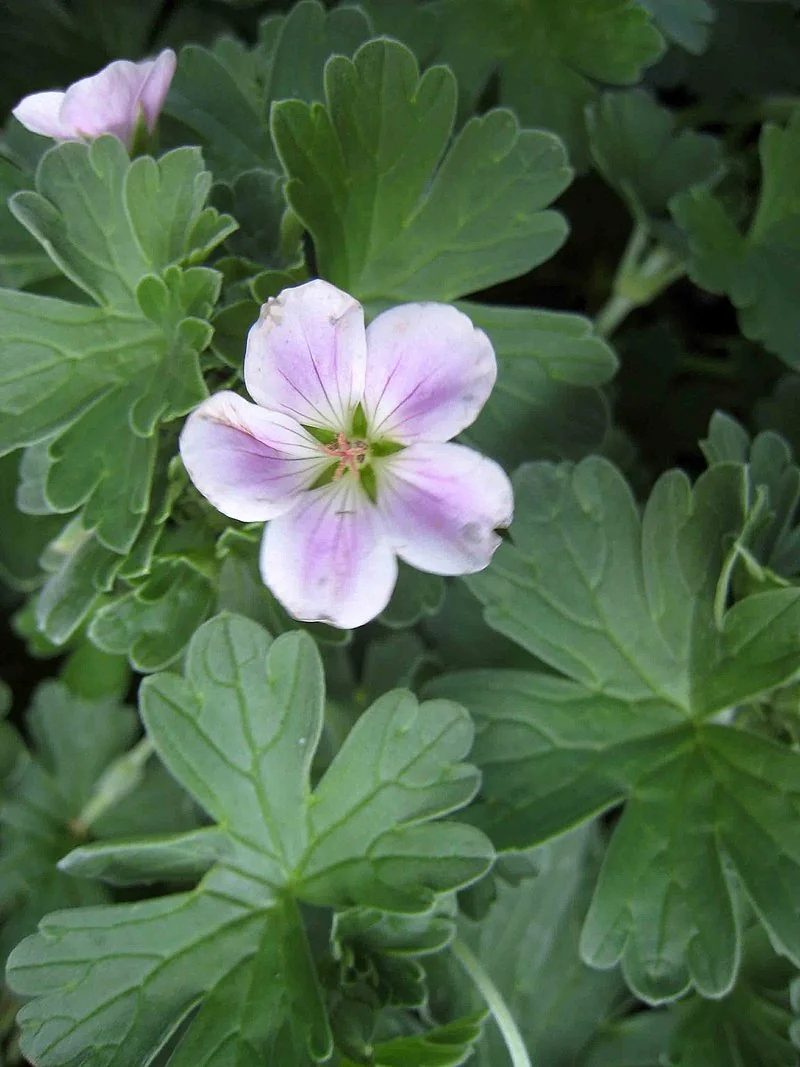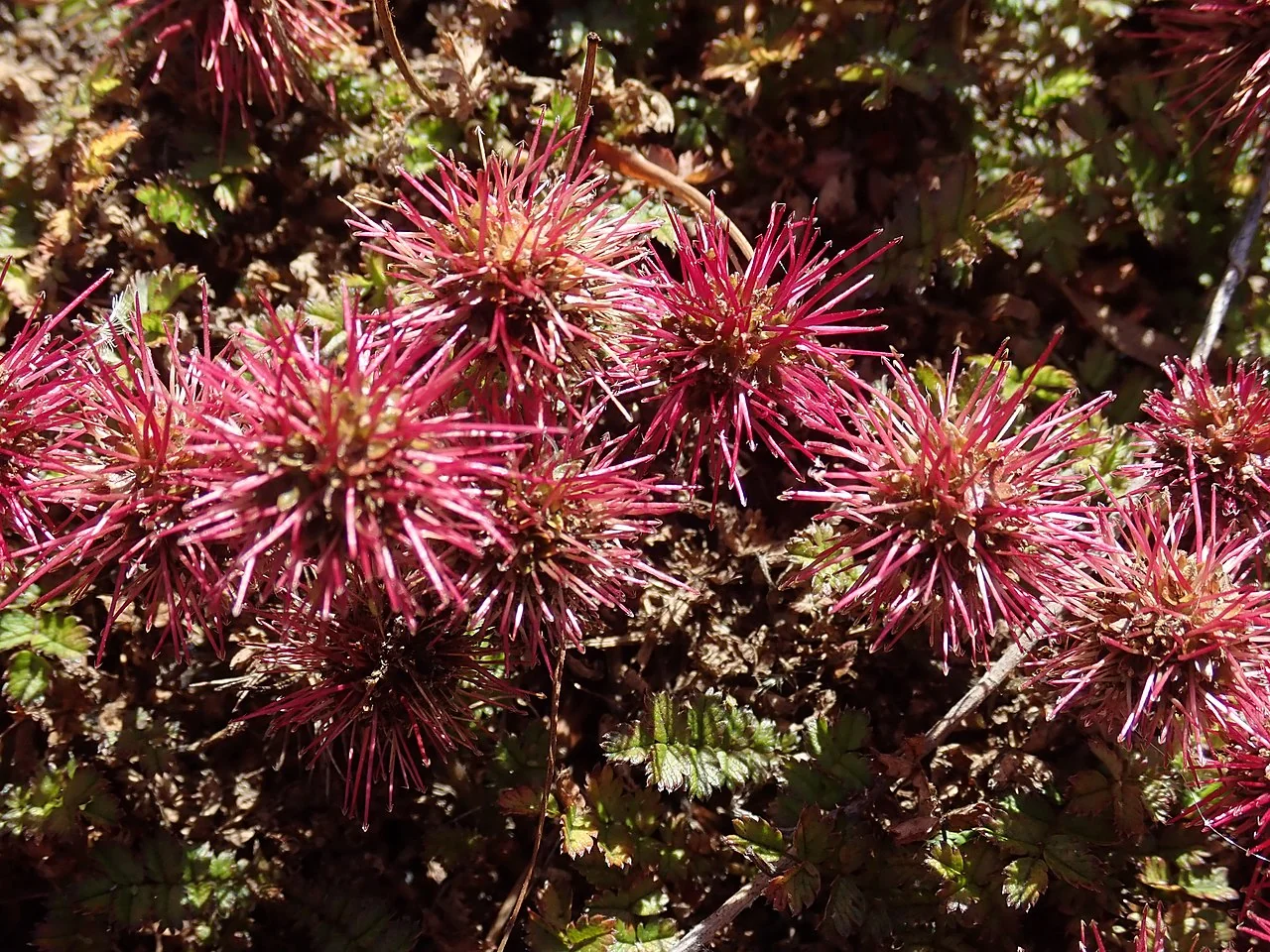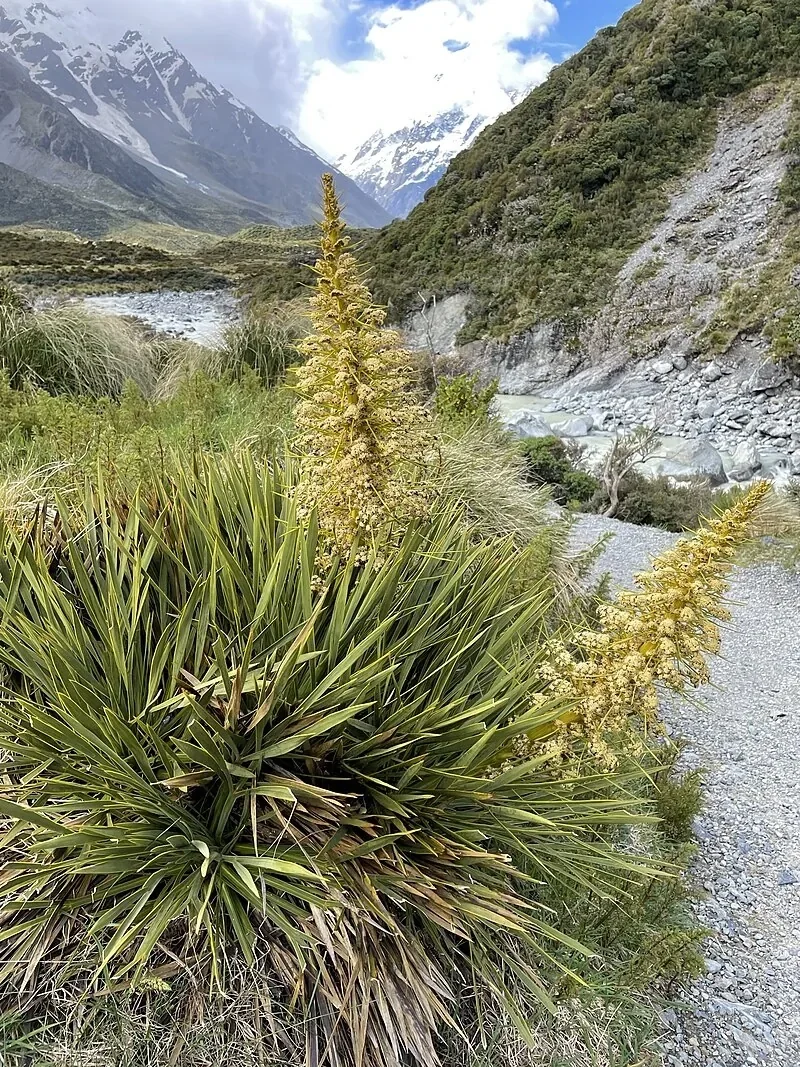
Chatham Island Geranium
Geranium traversii
Explore more NZ native plant guides in our index .
Chatham Island Geranium ( Geranium traversii ) is a beautiful and distinctive native New Zealand perennial, endemic to the Chatham Islands. It is highly valued for its attractive, deeply lobed, silvery-green leaves and its profusion of delicate, cup-shaped pink flowers that bloom for an extended period. This hardy geranium forms a low-growing, spreading mound, making it an excellent groundcover or rock garden plant. Its resilience and charming appearance have made it a popular choice in gardens both within New Zealand and internationally, showcasing the unique flora of the Chatham Islands.

Plant Description
Botanical Features
Geranium traversii , commonly known as Chatham Island Geranium, is a beautiful and distinctive perennial herb endemic to the Chatham Islands of New Zealand. It typically grows as a low-growing, herbaceous perennial, forming dense patches up to 80x60 cm. Its leaves are green, round, 2.5-7.5 cm in diameter, and deeply cut into 5 to 7 lobes. They can also be silvery-grey to grey-green and occasionally have a purple tinge. The plant produces cup-shaped flowers that are about 1 cm in diameter and can be white, pink, or almost lilac. These flowers appear in terminal spikes and bloom from spring through summer. This species is found in a variety of habitats on the Chatham Islands, thriving in full sun and tolerating coastal conditions, including wind and salt spray. It is a relatively robust plant that can be cultivated in most situations, making it a popular choice for gardens both within New Zealand and internationally.
Quick Facts
| Scientific Name | Geranium Traversii |
|---|---|
| Common Name | Chatham Island Geranium |
| Family | Geraniaceae |
| Height | Up to 30 cm |
| Spread | Up to 60 cm |
| Light | Full sun to partial shade |
| Soil | Well-drained, fertile soils |
| Water Needs | Moderate |
| Frost Tolerance | Moderate |
| Salt Tolerance | High |
| Growth Rate | Medium |
| Lifespan | Perennial |
Climate Best Suited to
Chatham Island Geranium ( Geranium traversii ) is endemic to the Chatham Islands, which experience a cool, oceanic climate with moderate temperatures, high humidity, and consistent rainfall. It is well-adapted to coastal conditions, tolerating strong winds and salt spray. While it thrives in these mild, maritime environments, it can be successfully cultivated in other temperate regions, provided it has good drainage and protection from extreme heat or prolonged severe frosts. Its natural habitat includes coastal cliffs, dunes, and open areas.
Regional Suitability
| Whangārei | Ideal |
| Auckland | Ideal |
| Hamilton | Suitable |
| Rotorua | Suitable |
| Tauranga | Ideal |
| Gisborne | Ideal |
| New Plymouth | Ideal |
| Whanganui | Ideal |
| Palmerston North | Suitable |
| Napier | Ideal |
| Wellington | Ideal |
| Nelson | Ideal |
| Christchurch | Suitable |
| Dunedin | Suitable |
| Invercargill | Suitable |
| City | Climate Suitability |
|---|
Natural Habitat
Typical Environments
Understand the natural habitat of Chatham Island Geranium ( Geranium traversii ), which is exclusively found on the Chatham Islands of New Zealand. This section details its geographical distribution, preferred environmental conditions, and the types of ecosystems where it naturally occurs.
- Endemic to the Chatham Islands.
- Found on coastal cliffs, dunes, and open areas.
- Prefers well-drained sites with good air circulation.
- Thrives in full sun to partial shade in oceanic climates.
Its restricted natural range highlights its unique evolutionary history and the importance of protecting its specific habitats.
Plant Conservation
Geranium traversii , also known as the Chatham Island geranium, is a perennial herb endemic to the Chatham Islands of New Zealand. While it is not currently classified as "threatened," its conservation status is "At Risk - Naturally Uncommon" with qualifiers for being Island Endemic (IE) and Range Restricted (RR). Although generally abundant and secure on most of the outer vegetated islands, it has likely declined in parts of its former range on Chatham and Pitt Islands. A primary threat to Geranium traversii in some locations is invasive weeds, particularly marram grass ( Ammophila arenaria ). Geranium traversii thrives in various coastal habitats, including cliffs, sand dunes, and rock crevices. It is easily grown from fresh seed and is amenable to cultivation, preferring full sun and well-draining soil. This makes it one of the few Chatham Islands endemic plants that can be readily grown throughout New Zealand.
Growing Requirements
Soil Requirements
Chatham Island Geranium prefers well-drained, fertile soils. It is adaptable to a range of soil types, including sandy or loamy soils, but good drainage is essential to prevent root rot. Incorporating organic matter can improve soil structure and fertility. A neutral to slightly alkaline pH is generally preferred.
- Prefers well-drained, fertile soils.
- Adaptable to sandy or loamy soil types.
- Good drainage is essential.
- Neutral to slightly alkaline pH preferred.
Light Requirements
Chatham Island Geranium performs best in full sun to partial shade. In full sun, it tends to be more compact and produce a greater abundance of flowers. In partial shade, it may grow a bit more sprawling but will still thrive. Ensure it receives adequate light for healthy growth and flowering.
- Full sun to partial shade.
- More flowers in full sun.
- Adaptable to various light conditions.
Water Requirements
Chatham Island Geranium requires moderate watering, especially during dry periods and its establishment phase. Once established, it is reasonably drought-tolerant but will benefit from occasional deep watering during prolonged dry spells. Ensure the soil is consistently moist but not waterlogged.
- Moderate watering needs.
- Drought-tolerant once established.
- Avoid waterlogging.
Planting Guide
Best Time to Plant
The best time to plant Chatham Island Geranium is during spring or early autumn, when temperatures are mild and rainfall is more consistent. This allows the plant to establish its root system before the extremes of summer heat or winter cold.
Choosing a Location
Select a site with full sun to partial shade and well-drained, fertile soil. It is ideal for borders, rock gardens, banks, or as a groundcover. Ensure it has good air circulation and is protected from strong, persistent winds if in an exposed location.
Planting Steps
- Dig a hole twice the width of the root ball and the same depth.
- Gently remove the plant from its container, being careful not to disturb the roots.
- Place the plant in the hole, ensuring the top of the root ball is level with the surrounding soil.
- Backfill with amended soil, firming gently around the base of the plant.
- Water thoroughly immediately after planting to settle the soil.
- Apply a light layer of organic mulch to help retain moisture and suppress weeds, keeping it away from the stem.
Initial Care
Water regularly during the first 6-12 months to help establish a strong root system. Once established, Chatham Island Geranium is reasonably low maintenance and requires less frequent watering. Protect young plants from extreme conditions if necessary.
Ecological Role
Ecosystem Roles
The ecological importance of Chatham Island Geranium ( Geranium traversii ) within its native Chatham Islands ecosystems is significant. Its flowers provide nectar for native insects, and its seeds may be a food source for small birds, contributing to the local food web.
- Flowers provide nectar for native insects.
- Seeds may be a food source for small birds.
- Helps stabilize soil in coastal and open areas.
- Contributes to the unique biodiversity of the Chatham Islands.
As an endemic species, it is an integral part of the unique biodiversity that has evolved in the Chatham Islands, supporting the delicate balance of its natural habitats.
Uses and Significance
Garden Uses
- Excellent groundcover for borders, rock gardens, and banks.
- Suitable for coastal gardens due to its salt tolerance.
- Provides extended flowering with delicate pink blooms.
- Attracts pollinators, such as bees, to the garden.
Cultural Significance
While specific cultural significance for Geranium traversii is not extensively documented, the genus Geranium, commonly known as cranesbills, holds various cultural and traditional significances across different regions.
General Cultural Significance of the Geranium Genus Includes:
- Symbolism: Wild Geraniums are often associated with gentility, calmness, and peace in the language of flowers.
- Historical Value: Historically, they have been valued by various cultures, including Native American tribes, for their serene presence and were used in early American settlements to bring a touch of wilderness into gardens.
Geranium traversii itself is a species endemic to the Chatham Islands of New Zealand. While it is a member of the culturally significant Geranium genus, specific cultural uses or folklore directly attributed to Geranium traversii are not detailed in available information.
Landscaping Applications
Chatham Island Geranium ( Geranium traversii ) is a highly versatile and attractive plant for various landscaping applications, particularly in native and low-maintenance gardens. Its low-growing, spreading habit and extended flowering make it a valuable asset.
- Ideal for borders, rock gardens, and groundcover.
- Excellent for coastal gardens due to its salt tolerance.
- Provides long-lasting floral display with delicate pink blooms.
- Suitable for mass plantings or as an accent plant.
Its ability to thrive in challenging conditions and its aesthetic appeal make it a popular choice for creating resilient and beautiful native landscapes.
Seasonal Care Calendar
Spring
New growth emerges, and flowering begins. This is an ideal time for planting new Chatham Island Geranium specimens or propagating from cuttings. Ensure consistent moisture and protect young plants from late frosts. A light feed with a balanced liquid fertilizer can encourage vigorous growth.
- Ideal time for planting and propagation.
- Ensure consistent moisture.
- Protect from late frosts.
Summer
Chatham Island Geranium is actively growing and flowering profusely during summer. Consistent watering is crucial, especially during dry spells, to prevent wilting. Monitor for pests and diseases, though it is generally quite resilient.
- Active growth and abundant flowering.
- Consistent watering is essential.
- Monitor for pests and diseases.
Autumn
Flowering may continue into autumn, and seeds will begin to ripen. This is another good time for planting, allowing roots to establish before winter. Minimal care is required for established plants, but ensure they remain adequately hydrated.
- Flowering continues, seeds ripen.
- Good time for planting.
- Ensure adequate hydration.
Winter
Chatham Island Geranium is largely dormant during winter. It is moderately frost-tolerant, but in very cold regions, young plants may benefit from some protection. Ensure good drainage to prevent root issues in wet conditions.
- Dormant period.
- Protect young plants from severe frost.
- Ensure good drainage.
When to Prune and How Much
Chatham Island Geranium generally requires minimal pruning. The primary reason for pruning is to remove spent flowers to encourage further blooming, or to tidy up the plant's appearance. Light trimming can encourage denser growth.
- Remove spent flowers (deadhead) to prolong blooming.
- Light trimming to maintain shape and encourage density.
- Best done after the main flush of flowers or in late winter/early spring.
- Use clean, sharp tools.
Avoid heavy pruning, as this can stress the plant. Its natural spreading habit is part of its charm, so allow it to grow naturally.
How to Grow Chatham Island Geranium
Chatham Island Geranium is a beautiful and distinctive native perennial, endemic to the Chatham Islands. It is highly valued for its attractive, deeply lobed, silvery-green leaves and its profusion of delicate, cup-shaped pink flowers that bloom for an extended period. This hardy geranium forms a low-growing, spreading mound, making it an excellent groundcover or rock garden plant. Its resilience and charming appearance have made it a popular choice in gardens both within New Zealand and internationally, showcasing the unique flora of the Chatham Islands. Understanding its propagation methods is key to successfully growing this delightful species.
From Seed
Propagating Chatham Island Geranium from fresh seed is a viable method, though germination can be slow and variable. Collect ripe seeds in late summer or early autumn. Clean the seeds thoroughly to remove any fleshy pulp. Sow the seeds in a tray filled with a well-draining seed-raising mix, lightly covering them. Maintain consistent moisture in the seed tray and keep it in a warm, sheltered location. Germination can take several weeks to months, so patience is key. Once seedlings have developed a few true leaves, they can be potted into individual containers and grown in a sheltered environment before planting out. Note that plants grown from seed may show some variation from the parent plant.
From Cuttings
Softwood or semi-hardwood cuttings are the most reliable and efficient method for propagating Chatham Island Geranium, ensuring that new plants retain the exact characteristics of the parent. Take 5-10 cm cuttings from healthy, non-flowering stems in spring or summer. Remove the lower leaves and dip the cut end in a rooting hormone. Insert the cuttings into a well-draining propagation mix, such as a blend of perlite and sand. Keep the cuttings in a warm, humid environment, out of direct sunlight, perhaps under a plastic dome or in a propagator. Rooting typically occurs within 4-6 weeks. Once rooted, the new plants can be potted on and grown in a sheltered environment until they are ready for planting.
From Division
Established clumps of Chatham Island Geranium can be easily divided in spring or autumn to create new plants. Carefully dig up a mature clump and gently separate it into smaller sections, ensuring each section has a healthy portion of roots and some foliage. Replant the divisions immediately into well-prepared soil that is well-draining and fertile. Water thoroughly after planting and keep consistently moist until established. This method is excellent for quickly expanding your stock of plants and for rejuvenating older, less vigorous clumps.
Pests and Diseases
Chatham Island Geranium is generally a robust plant, but it can be susceptible to certain pests and diseases, especially if not grown in optimal conditions.
Common Pests
- Slugs and Snails: Can damage young plants and tender new shoots. Use barriers or baits.
- Aphids: Can infest new growth. Treat with insecticidal soap or remove manually.
Common Diseases
- Powdery Mildew: A fungal disease that can occur in humid conditions with poor air circulation. Ensure good air circulation and remove affected leaves.
- Root Rot: Caused by overwatering or poor drainage. Ensure well-drained soil.
Good garden hygiene, proper watering, and adequate air circulation are key to preventing most pest and disease issues. Regular inspection will help catch problems early.
Bonus Tip
A Nod to a Naturalist
The species name, traversii , honours William Thomas Locke Travers, a 19th-century Irish lawyer, politician, explorer, and naturalist who made significant contributions to the study of New Zealand's natural history. Naming the plant after him was a fitting tribute to his passion for the country's unique flora.







